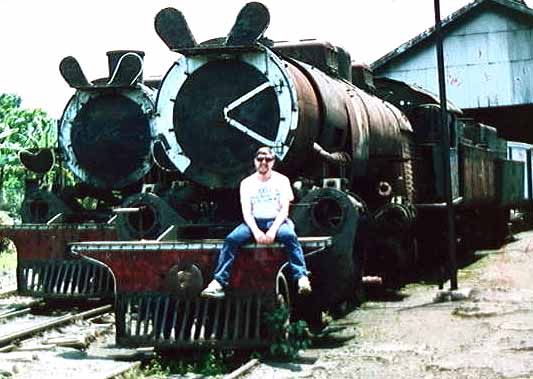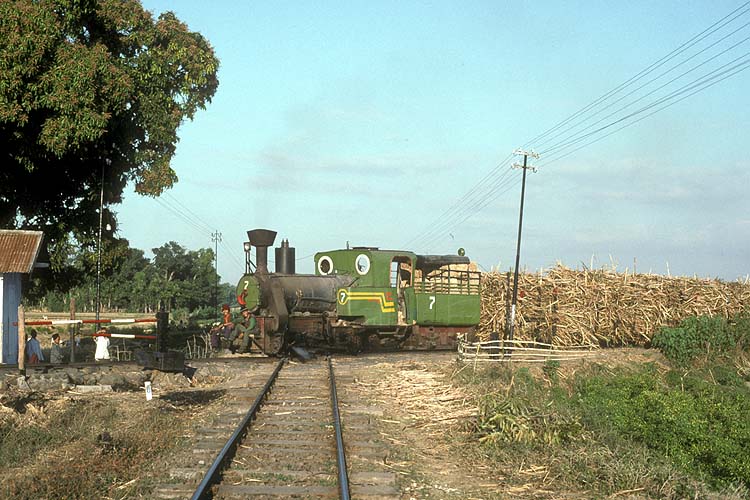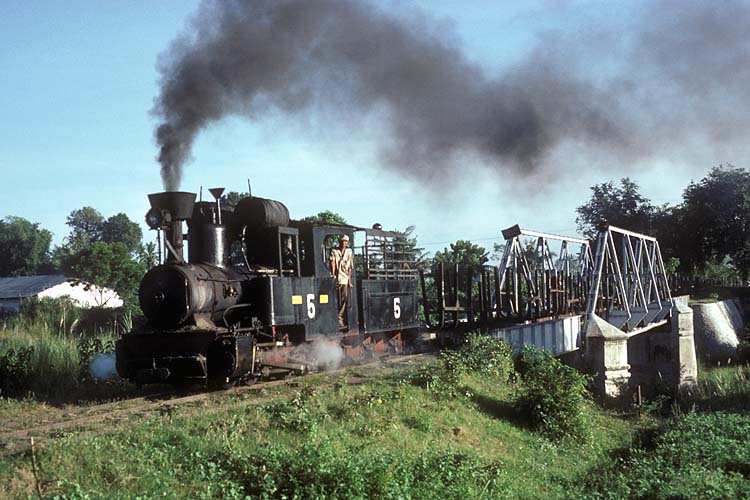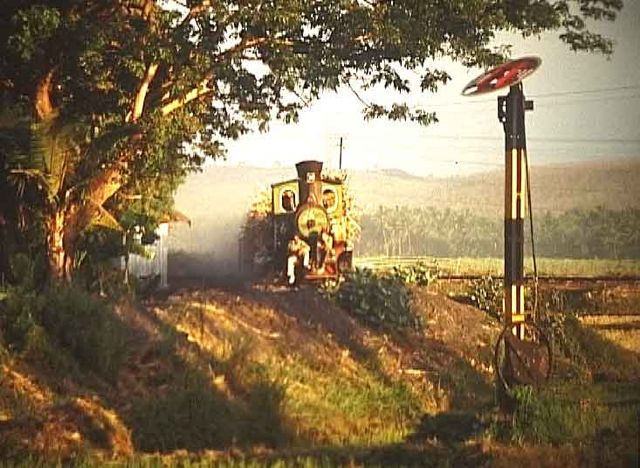Steamy Java 2012 Blog
Last updated 9 August 2012
Pre-Tour
1 |
||||
Steamy Java 2012
DVD (Details Later) |

A visit to Cibatu Shed in the 1990s to see what was left there (several derelict CC50 mallets). What will we find in Java in 2012? The 2012 visit is in conjunction with the Farrail Java Tour.
For convenience, this blog will be on several different pages of which this is the first.
Mill Railway Overview (field or yard work, steam, diesel, tractor or no rail)
Pre-Tour (14-16 July)
Heritage Railway Walk – Situbondo – Wringinanom
circuit (below)
Do 'Real Steam' daytime
field trains still exist in Java
(new page)
Exploratory Visit to Krebet Baru
field lines near Malang (now
added 16 July)
Diesel Tour
17-25 July
First part of tour (completed)
Second part of tour (completed)
Steam Tour
26 July - 11 August
First part of tour (completed)
Second part of tour
(completed)
Third part of tour
(started 6 August)
14 July 2012
Heritage
Railway Walk – Situbondo – Wringinanom circuit
Following a journey of 30 hours and a midnight arrival, I felt the need
for a short walk to acclimatize. Although I headed into town for a bit
of shopping, I was distracted by my hunt for the old railway link from
Olean sugar mill that shipped bagged sugar out to the national railway
at Situbondo. Once at the station, I decided to walk to the flat crossing
with the Wringinanom system and then part-way back along the narrow
gauge to the mill. If anyone replicates this walk, please take plenty
of water!
Leaving the Hotel Rosali, walk
towards town and turn right at the first set of traffic lights. The
old link line crossed the main road here. The first view is looking
back towards the main road and towards Olean Mill. I assume the line
was on the right hand side at this point.

Continue along this road (signed
as a bypass to Bondowoso) crossing the river with a twin road bridge.
There is still no sign of the former rail link but it is apparent on
the right hand side shortly after that where it crossed a canal.

The line has curved away from
the road and is now heading for the station which can be accessed from
a small road on the right after the remains of the railway over canal
bridge. The station has great views of the nearby mountains and was
isolated from the town which must have been unpopular in the past. The
line ran from the port of Panarukan to join the Surabaya – Banyuwangi
line east of Jember which was also not very convenient as most people
would want to travel along the north coast between Banyuwangi (for Bali)
and Surabaya. The last time I saw a service train on this line was 2005
or earlier. In 2008, we visited the station at Bondowoso and established
that a trolley was still used to inspect the line onwards towards Prajakan
but the line has never re-opened.

There is a single wagon left at the Panarukan end of the platform at
Situbondo which has made its last journey.

Of the transfer point between the 700mm Olean system and the 3ft 6in
national railways, there is no obvious sign which raises the question
of whether the link was 3ft 6in gauge which would not have needed transshipment.
If it was, this would also have implications for the historic bagged
sugar exports from Wringinanom mill. Did that mill export its sugar
over the link between itself and Olean (700mm gauge) or was there a
link from Wringinanom to the port station at Panarukan (and if so, what
was the gauge?)
From the former Situbondo Station, the walk proper starts with a pleasant
stroll along the line towards Panarukan with views of Mt Ringgit (1250m)
and rice paddies.

The track is still in place and there is a path along the track or parallel
to it the whole way.

At times, the farm yard has taken over the track but the route is never
completely obstructed.

After about 2km, you reach a small station or halt which has become
a farm house.

Shortly after, the railway crosses the only road on this section of
the line and we head on towards the flat crossing with the Wringinanom
system.

This was the signal for the
flat crossing.

After approximately 3 km from the start, we reach the flat crossing.
If, like me, you are here during the sugar season, the chances are that
these narrow gauge rails going left to right will be in use between
the fields and the sugar mill.

Rob Dickinson has sent me a shot of steam on the flat crossing to add.
The link to his webpage on Wringinanom is below.

We turn right here and follow the Wringinanom 700mm tracks back to the
mill. If you are lucky, there may be 2 diesels parked up at the road
crossing ahead waiting for instructions to go to the fields to collect
loaded trains.


The Wringinanom system was once famous for a magnificent bridge over
the River Sampean here but this was washed away between 2005 and 2008
and in 2008, we saw trains operating on the isolated system on the other
side before loading the cane into road trucks for transfer to the mill.
The new bridge links up the system again but is less impressive.

Rob Dickinson has sent me a
shot of steam crossing the bridge to add. The link to his webpage on
Wringinanom is below.

Many thanks to Rob Dickinson
for the two historic photos. To see more of what it used to be like,
Rob's Wringinanom web page is here.
The crossing for the main Surabaya – Banyuwangi road comes next.
If you have already a ball of sweat, you can catch a minibus back to
the hotel here.

However, a walk along the Wringinanom mainline back to the mill is pleasant
and gives the chance of seeing more railway heritage. The line to the
north joins and although the points were set for the way we have come
from the south, the north line looks used.
Shortly afterwards, temporary track goes into a field that has already
been cleared of cane. The temporary junction has been removed.

Ahead, we see permanent points into a field which is being cut with
wagons being loaded to be taken to the mill later today.

Wringinanom Mill is now beginning to get closer.

We pass another junction, this one the link to the Olean system and
them bear around to head towards the back of the mill. There is a road
out on the left by a small shop but it’s probably more interesting
to continue to the back of the mill via the weighbridge.

And then we are at the back of the mill with large loco No. 5 dwarfing
tiny No. 1. There is no security around today to stop me but entering
further into the mill yard requires permission. Outside the mill yard
is a triangle which is probably used to make up double lengths of loaded
wagons in the mill sidings. (If so, the first train goes straight into
the mill sidings and the loco comes off of the front. The second train
goes the other route round the triangle and reverses the load into the
mill siding so a double length train is ready for the mill and the loco
is not trapped in the middle.) This area has various bits of scrap around
including loco and tender parts.

Here is my own (low res) shot of what it was like in steam days. The disk signal (linked to the catch points at the crossing) is still there but no longer used. The trees have gone for firewood.

By now, like me, you will probably
be hot and sticky so head for the main road and catch a minibus back
to the hotel. If you decide to walk along the main road, it’s
about 2 km back to the Hotel Rosali.

Back at the hotel after 2.5 hours out in the heat (10:30 – 1:00),
the beers in the restaurant fridge look tempting.

And on the table, even more so with Ayam saos Inggris (chicken in Worcester
sauce) and kentang goreng (chips). Cheers!

If anyone does this walk, please let me know. You can contact me at john@linesiding.co.uk